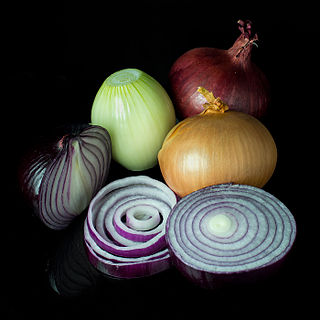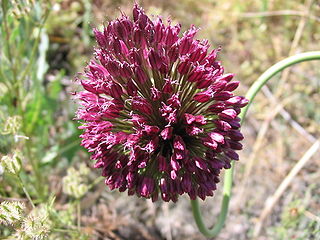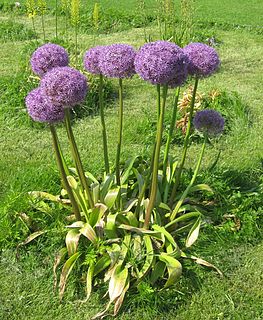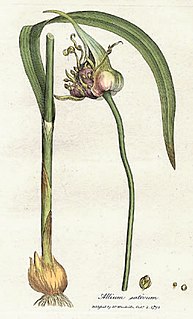
Chives, scientific name Allium schoenoprasum, is a species of flowering plant in the family Amaryllidaceae that produces edible leaves and flowers. Their close relatives include the common onions, garlic, shallot, leek, scallion, and Chinese onion.

The onion, also known as the bulb onion or common onion, is a vegetable that is the most widely cultivated species of the genus Allium. The shallot is a botanical variety of the onion which was classified as a separate species until 2010. Its close relatives include garlic, scallion, leek, chive, and Chinese onion.

In botany, a bulb is structurally a short stem with fleshy leaves or leaf bases that function as food storage organs during dormancy.

Allium ursinum, known as wild garlic, ramsons,wild cowleek, cowlic, buckrams, broad-leaved garlic, wood garlic, bear leek or bear's garlic, is a bulbous perennial flowering plant in the amaryllis family Amaryllidaceae. It is native to Europe and Asia, where it grows in moist woodland. It is a wild relative of onion and garlic, all belonging to the same genus, Allium. There are two recognized subspecies: A. ursinum subsp. ursinum and A. ursinum subsp. ucranicum.

Allium tricoccum is a North American species of wild onion widespread across eastern Canada and the eastern United States. Many of the common English names for this plant are also used for other Allium species, particularly the similar Allium ursinum, which is native to Europe and Asia.

Scilla siberica, the Siberian squill or wood squill, is a species of flowering plant in the family Asparagaceae, native to southwestern Russia, the Caucasus, and Turkey. Despite its name, it is not native to Siberia.

Allium vineale is a perennial, bulb-forming species of wild onion, native to Europe, northwestern Africa and the Middle East. The species was introduced in Australia and North America, where it has become a noxious weed.

Hyacinthus orientalis, the common hyacinth, garden hyacinth or Dutch hyacinth, is a species of flowering plant in the family Asparagaceae, subfamily Scilloidiae, native to southwestern Asia, southern and central Turkey, northwestern Syria, Lebanon and northern Israel. It was introduced to Europe in the 16th century. It is widely cultivated everywhere in the temperate world for its strongly fragrant flowers which appear exceptionally early in the season, and frequently forced to flower at Christmas time.

Allium sphaerocephalon is a plant species in the Amaryllis family known as round-headed leek, round-headed garlic, ball-head onion, and other variations on these names. Drumstick allium is another common name applied to this species. Some publications use the alternate spelling Allium sphaerocephalum. It is a bulbous herbaceous perennial plant.

Allium anceps, known as twinleaf onion and Kellogg's onion, is a species of wild onion native to the western United States. It is widespread in Nevada, extending into adjacent parts of California, Idaho, and Oregon. It grows in barren clay and rocky soils.

Allium caeruleum is an ornamental bulbous plant of the onion genus, native to Central Asia. In these regions, it is found on dry slopes, plains, and steppes.

Allium giganteum, common name giant onion, is an Asian species of onion, native to central and southwestern Asia but cultivated in many countries as a flowering garden plant. It is the tallest species of Allium in common cultivation, growing to 1.5 metres (4.9 ft).

Ipheion uniflorum is a species of flowering plant, related to the onions, so is placed in the allium subfamily (Allioideae) of the Amaryllidaceae. It is known by the common name springstar, or spring starflower. Along with all the species of the genus Ipheion, some sources place it in the genus Tristagma, but research published in 2010 suggested that this is not correct. It is native to Argentina and Uruguay, but is widely cultivated as an ornamental and reportedly naturalized in Great Britain, France, Australia, New Zealand and the United States.

Eucomis vandermerwei is a South African bulbous perennial flowering plant, a member of the asparagus family, and like other members of Eucomis is commonly known as pineapple lily for its superficial resemblance to that plant, although not closely related to it. This species is one of the smallest in the genus, and is native to a high-rainfall region of western Mpumalanga in South Africa. The dense rosette of leaves, either prostrate or ascending, is heavily blotched with purple, and the leaf-edges are markedly crisped or wavy. The star-shaped burgundy flowers appear in midsummer, and are borne on a spike (raceme) topped by a "head" of leafy bracts.

Ornamental bulbous plants, often called ornamental bulbs or just bulbs in gardening and horticulture, are herbaceous perennials grown for ornamental purposes, which have underground or near ground storage organs. Botanists distinguish between true bulbs, corms, rhizomes, tubers and tuberous roots, any of which may be termed "bulbs" in horticulture. Bulb species usually lose their upper parts during adverse conditions such as summer drought and heat or winter cold. The bulb's storage organs contain moisture and nutrients that are used to survive these adverse conditions in a dormant state. When conditions become favourable the reserves sustain a new growth cycle. In addition, bulbs permit vegetative or asexual multiplication in these species. Ornamental bulbs are used in parks and gardens and as cut flowers.

Allium bisceptrum, also known as the twincrest onion or aspen onion, is a high elevation plant native to western United States. It is a perennial that thrives under damp and shady conditions or open meadows in California, Arizona, New Mexico, Nevada, Oregon, Washington, Idaho, and Utah.

Allium stipitatum, Persian shallot, is an Asian species of onion native to central and southwestern Asia.

Allium hollandicum, the Persian onion or Dutch garlic, is a species of flowering plant native to Iran and Kyrgyzstan but widely cultivated as an ornamental because of its umbels of attractive purple flowers. It is reportedly naturalized in Saint Louis County, Minnesota.

Allium insubricum, the Lombardy garlic, is a species of flowering plant endemic to the Lombardy region in northern Italy. It is named for Insubria, the ancient name for the area around present-day Milan. The species is, however, widely cultivated as an ornamental because of its striking flowers. Its locus classicus is located in Canzo.

Allium is a genus of monocotyledonous flowering plants that includes hundreds of species, including the cultivated onion, garlic, scallion, shallot, leek, and chives. The generic name Allium is the Latin word for garlic, and the type species for the genus is Allium sativum which means "cultivated garlic".





















